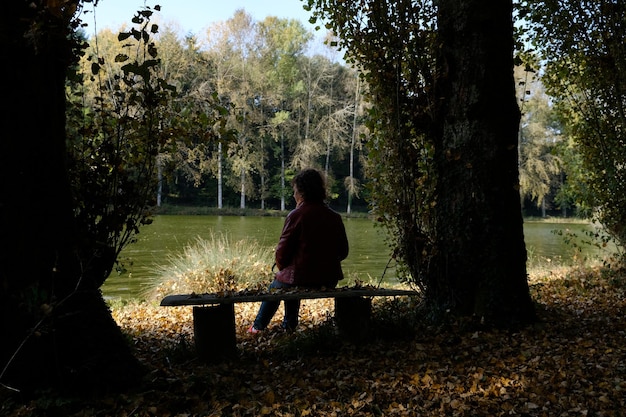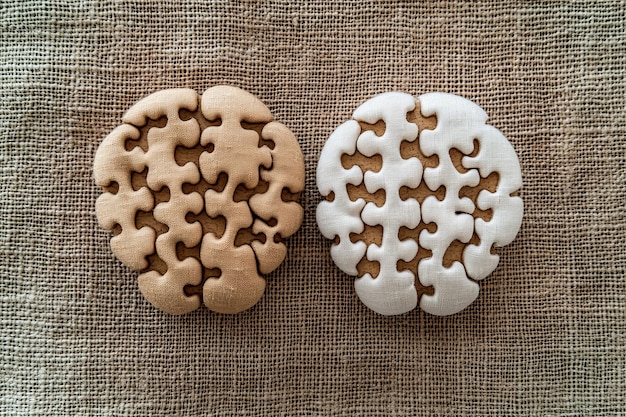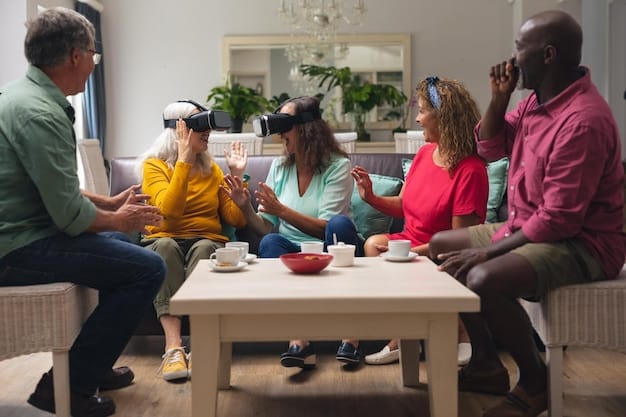Understanding and Coping with PTSD: Resources and Support

Understanding and Coping with Post-Traumatic Stress Disorder (PTSD): Resources and Support involves recognizing symptoms, seeking professional help, utilizing coping strategies, and building a strong support system to improve mental wellness and overall quality of life.
Understanding and Coping with Post-Traumatic Stress Disorder (PTSD): Resources and Support is crucial for individuals who have experienced trauma. PTSD can significantly impact daily life, but with the right understanding, resources, and support, recovery is possible.
What is Post-Traumatic Stress Disorder (PTSD)?
Post-Traumatic Stress Disorder, commonly known as PTSD, is a mental health condition triggered by a terrifying event—either experiencing it or witnessing it. Symptoms can include flashbacks, nightmares, and severe anxiety, as well as uncontrollable thoughts about the event.
Although many people experience trauma, not everyone develops PTSD. The condition can affect anyone, including military personnel, first responders, and civilians.

Key Diagnostic Criteria for PTSD
- Exposure to actual or threatened death, serious injury, or sexual violence.
- Presence of one or more intrusion symptoms associated with the traumatic event(s), beginning after the traumatic event(s) occurred.
- Persistent avoidance of stimuli associated with the traumatic event(s).
- Negative alterations in cognitions and mood associated with the traumatic event(s).
- Marked alterations in arousal and reactivity associated with the traumatic event(s).
These criteria, outlined in the DSM-5, help mental health professionals accurately diagnose PTSD and ensure individuals receive appropriate treatment.
In conclusion, understanding what PTSD is its diagnostic criteria can help individuals recognize the symptoms and seek timely help, leading to better management and recovery.
Recognizing the Symptoms of PTSD
Recognizing the symptoms of PTSD is essential for early detection and intervention. Symptoms can vary from person to person, but they generally fall into four main categories: intrusion, avoidance, alterations in cognition and mood, and alterations in arousal and reactivity.
Understanding these symptoms can empower individuals to seek help and support, leading to a more effective path to recovery.
Intrusion Symptoms
Intrusion symptoms involve reliving the traumatic event through:
- Recurrent, involuntary, and intrusive distressing memories of the traumatic event.
- Traumatic nightmares.
- Flashbacks, in which the individual feels or acts as if the traumatic event were recurring.
- Intense or prolonged psychological distress at exposure to internal or external cues that resemble an aspect of the traumatic event.
Avoidance Symptoms
Avoidance symptoms include:
- Efforts to avoid distressing memories, thoughts, or feelings about or closely associated with the traumatic event.
- Efforts to avoid external reminders (people, places, conversations, activities, objects, situations) that arouse distressing memories, thoughts, or feelings about or closely associated with the traumatic event.

Alterations in Cognition and Mood
Alterations in cognition and mood can manifest as:
- Persistent and exaggerated negative beliefs or expectations about oneself, others, or the world.
- Persistent distorted cognitions about the cause or consequences of the traumatic event(s) that lead the individual to blame himself/herself or others.
- Persistent negative emotional state (e.g., fear, horror, anger, guilt, or shame).
- Markedly diminished interest or participation in significant activities.
Alterations in arousal and reactivity include:
- Irritable behavior and angry outbursts (with little or no provocation) typically expressed as verbal or physical aggression toward people or objects.
- Reckless or self-destructive behavior.
- Hypervigilance.
- Exaggerated startle response.
In conclusion, knowing these symptoms can enable individuals to recognize PTSD in themselves or others, facilitating early intervention and support.
Effective Coping Strategies for PTSD
Developing effective coping strategies is crucial for managing PTSD symptoms and improving overall quality of life. These strategies can help individuals regain a sense of control and resilience in the face of distressing memories and emotions.
Here are some proven coping strategies that can be integrated into daily routines to alleviate the impact of PTSD.
Mindfulness and Meditation
Mindfulness and meditation practices can help individuals stay grounded in the present moment, reducing the intensity of intrusive thoughts and flashbacks. Techniques include:
- Deep breathing exercises to calm the nervous system.
- Body scan meditations to increase awareness of physical sensations.
- Guided imagery to promote relaxation and reduce anxiety.
Engaging in Physical Activity
Regular physical activity can release endorphins, which have mood-boosting effects. Activities such as:
- Walking or jogging in nature.
- Yoga or Tai Chi to improve flexibility and reduce stress.
- Team sports to foster social connection and teamwork.
Establishing a Routine
Creating a structured daily routine can provide a sense of normalcy and predictability, which is particularly beneficial for individuals with PTSD. A routine may include:
- Setting consistent sleep and wake times.
- Planning regular meal times.
- Incorporating time for relaxation and hobbies.
Seeking Social Support
Connecting with others who understand and can offer support can significantly reduce feelings of isolation and distress. This includes:
- Joining a support group for individuals with PTSD.
- Sharing experiences with trusted friends and family members.
- Seeking guidance from a mental health professional who specializes in trauma.
In conclusion, integrating these coping strategies into daily life can help manage PTSD symptoms effectively, promoting emotional stability and resilience.
Seeking Professional Help and Treatment Options
Seeking professional help is a critical step in managing and recovering from PTSD. Various treatment options are available, each tailored to address specific symptoms and needs of the individual.
Understanding these treatments can empower individuals to make informed decisions about their care and embark on a path to healing.
Psychotherapy
Psychotherapy, or talk therapy, is a cornerstone of PTSD treatment. Effective approaches include:
- Cognitive Behavioral Therapy (CBT): Helps individuals identify and change negative thought patterns and behaviors.
- Eye Movement Desensitization and Reprocessing (EMDR): Facilitates the processing of traumatic memories through guided eye movements.
- Exposure Therapy: Gradually exposes individuals to trauma-related memories and situations in a safe and controlled environment.
Medications
Medications can help manage symptoms such as anxiety, depression, and insomnia associated with PTSD. Common medications include:
- Selective Serotonin Reuptake Inhibitors (SSRIs): Antidepressants that can improve mood and reduce anxiety.
- Serotonin-Norepinephrine Reuptake Inhibitors (SNRIs): Similar to SSRIs but affect different neurotransmitters.
- Prazosin: Can help reduce nightmares associated with PTSD.
Medication decisions should be made in consultation with a qualified healthcare provider.
Alternative Therapies
Alternative therapies can complement traditional treatments and promote holistic well-being. These may include:
- Acupuncture: Can help reduce stress and promote relaxation.
- Yoga: Combines physical postures, breathing techniques, and meditation to reduce anxiety and improve overall well-being.
- Art Therapy: Provides a creative outlet for expressing emotions and processing trauma.
In conclusion, seeking professional help and exploring different treatment options can significantly improve outcomes for individuals with PTSD, fostering long-term recovery and resilience.
Building a Support System
Building a strong support system is essential for individuals coping with PTSD. A supportive network can provide emotional validation, practical assistance, and a sense of belonging, all of which are crucial for healing.
Here are some strategies for building and maintaining a robust support system.
Connecting with Family and Friends
Nurturing relationships with family and friends can provide a sense of stability and connection. Strategies include:
- Sharing experiences and feelings with trusted loved ones.
- Participating in social activities and hobbies together.
- Setting healthy boundaries to protect emotional well-being.
Joining Support Groups
Support groups offer a safe and supportive environment to connect with others who understand the challenges of PTSD. Benefits include:
- Sharing experiences and insights with peers.
- Receiving encouragement and validation from others.
- Learning new coping strategies and resources.
Several national organizations offer PTSD support groups.
Seeking Community Resources
Community resources can provide additional support and assistance to individuals with PTSD. These may include:
- Mental health clinics and counseling services.
- Veterans’ organizations and support programs.
- Local community centers offering social and recreational activities.
In conclusion, building a supportive network can significantly enhance the recovery journey for individuals with PTSD, providing a sense of community and fostering emotional well-being.
Maintaining Long-Term Mental Wellness
Maintaining long-term mental wellness after trauma involves ongoing self-care, proactive management of symptoms, and continuous support. It’s about fostering resilience and creating a lifestyle that promotes emotional stability and overall well-being.
Here are key strategies to consider.
Consistent Self-Care Practices
Regular self-care practices are vital for sustaining mental wellness. Key components include:
- Prioritizing sleep to ensure adequate rest and recovery.
- Eating a balanced diet to nourish the body and mind.
- Engaging in activities that bring joy and relaxation.
Proactive Symptom Management
Proactive symptom management involves recognizing triggers and implementing strategies to mitigate their impact. Ideas include:
- Identifying early warning signs of increased stress or anxiety.
- Using coping techniques to manage distressing thoughts and emotions.
- Seeking professional support when needed.
Ongoing Support and Therapy
Continuing to engage with support networks and therapy can provide long-term benefits. Options include:
- Attending regular therapy sessions to address ongoing challenges.
- Participating in support groups to connect with peers.
- Staying connected with a supportive community.
Also:
- Re-evaluate your goals and priorities, and make adjustments as needed.
- Celebrate small achievements and milestones along the way.
In conclusion, maintaining long-term mental wellness after trauma requires a holistic approach that integrates self-care, symptom management, and ongoing support. By prioritizing mental health and fostering resilience, individuals can thrive and lead fulfilling lives.
| Key Aspect | Brief Description |
|---|---|
| 🧠 Understanding PTSD | Recognizing symptoms and diagnostic criteria. |
| 🧘♀️ Coping Strategies | Using mindfulness, physical activity, and routine. |
| 🧑⚕️ Professional Help | Seeking psychotherapy and medication options. |
| 🫂 Support System | Building connections with family, friends, and groups. |
Frequently Asked Questions (FAQs)
▼
PTSD develops after experiencing or witnessing a traumatic event, such as a natural disaster, accident, or violent assault, that causes intense fear and helplessness.
▼
A diagnosis of PTSD requires meeting specific criteria outlined in the DSM-5, which includes exposure to a traumatic event and experiencing related intrusion, avoidance, and alteration symptoms.
▼
Yes, medications like SSRIs and SNRIs are often prescribed to manage symptoms, as well as prazosin for nightmares, but these should always be monitored by a healthcare professional.
▼
They can provide emotional support, encourage professional help, and create a safe environment by being patient, understanding, and listening without judgment.
▼
With consistent therapy, coping strategies, and a strong support system, many individuals with PTSD can effectively manage their symptoms and lead fulfilling lives.
Conclusion
Understanding and Coping with Post-Traumatic Stress Disorder (PTSD): Resources and Support are available to help individuals heal and rebuild their lives. Recognizing the symptoms, seeking professional assistance, employing effective coping mechanisms, and creating a supportive network significantly contribute to the journey of recovery and long-term mental well-being.





